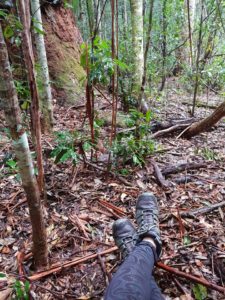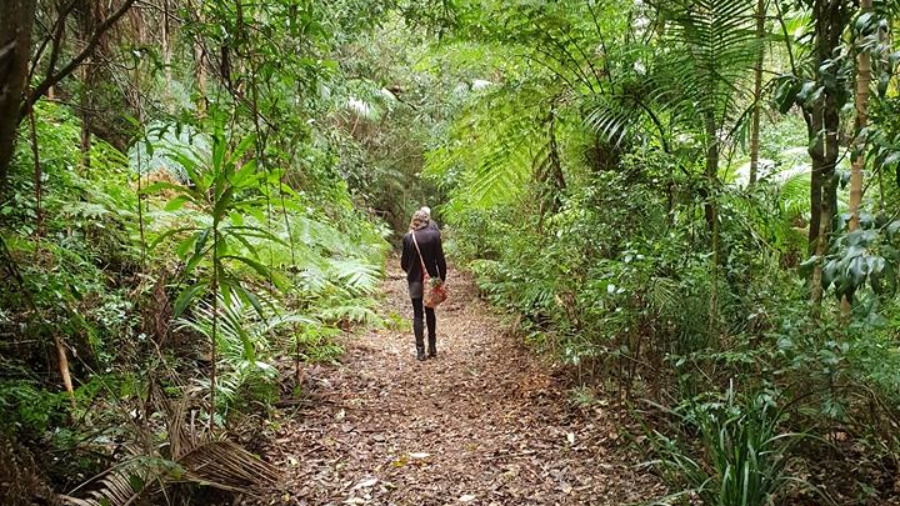First of all, you might be wondering what exactly is forest bathing?
Forest bathing is a nature connection practice inspired by the Japanese where it is called Shinrin Yoku.
It’s not about getting wet.
The idea is to fully immerse yourself in nature and to bathe all your senses (more than 12 of them!).
Put simply, it is about taking a slow mindful walk in nature, breathing in the forest air, sitting and observing, and developing an emotional connection to the forest. It is different from hiking, where the pace is faster and you miss a lot of what is going on around you. It is also different from a naturist walk, where you might be identifying and naming species of fauna or flora.
A Forest Bathing walk covers less than a kilometre usually over two or three hours. Its aim is to help you slow down and take a break from the stresses of daily life, and to appreciate things that can only be noticed when moving slowly. Some people describe it like doing meditation or mindfulness in nature.
So now that we know what it is. Why on earth would we want to do it?
1. Forest Bathing is Part of Our True Nature
Humans evolved out of forests. Our species spent millions years of in development within these ecosystems. Then our world experienced rapid industrialisation and we moved into cities. While genetically our bodies are optimized for the forest, we are now trying to survive in the busy, stressful conditions of modern civilization.
Our separation has caused what Richard Louv terms, ‘nature deficit disorder’. He argues that our children are spending so much less time outdoors than previous generations, it is having a detrimental impact on their development.
Rather than seeing ourselves as separate from nature, we must remember, we are nature.
2. Forest Bathing Promotes our Health and Wellbeing
In the Western world, rates of mental health problems are out of control. Over 50% of people are stressed at work. In Australia, 1 in 5 of us will go on to experience a mental illness. Many physical illnesses and disease can also be linked to stress as an underlying cause.
The Japanese have been studying the effects of forest bathing since the 1980’s. What they discovered was an antimicrobial organic compound called phytonicides that are given off by evergreen trees such as pines and eucalypts. When you breathe in phytonicides, your blood pressure drops, your cortisol level (or stress hormone) reduces and heart rate variablilty improves. Phytoncides are immune boosters which increase the natural killer cells in our body, associated with fighting cancer.
 Other research has shown that being in nature:
Other research has shown that being in nature:
- Improves your short term memory
- Restores your mental energy
- Relieves stress
- Reduces inflammation
- Improves your vision
- Improves your concentration
- Helps you think clearer and more creatively
- Boosts your immune system
- Improves mental health, reduce anxietyand depression
- helps you live longer
3. Forest Bathing Addresses Climate Change
I know, it’s a big call. But I firmly believe that if we are more closely connected to Mother Nature, we are more likely to want to care for and protect it. Ours is a reciprocal relationship. When the earth is sick, so are we (see point 2). We need healing and so does our earth.
Humans have become so separate from nature that there has been little regard to how we treat the earth. It has been seen as a collection of resources to be exploited for our benefit. On a guided forest bathing walk, there is particular attention paid to the practice of reciprocity. In supporting the development of human-nature relationships, we foster the role of humans as givers, as well as receivers.
People who engage regularly in forest bathing practices, tend to spontaneously find themselves engaging in place tending on a personal level or want to get involved in environmental activism at a macro level.
So rebuilding our intimate connection to the forest again, will ultimately lead to the healing of the planet and of course, our own health too.
If one or more of these reasons has inspired you to try forest bathing, then feel free to join the Japanese where is it called “Shinrin-yoku” (森林浴), the Germans practising “Waldtherapie”, the Koreans engaging in “Sanlimyok (산림욕)” and of course, the Australians, Americans and Europeans, where we use the terms “nature and forest therapy”.
If you are in the Central Gippsland region, you can join me on your very own private Nature therapy walk. Or you can find other Certified guides in Australia here and elsewhere in the world here.
Happy Forest Bathing!

